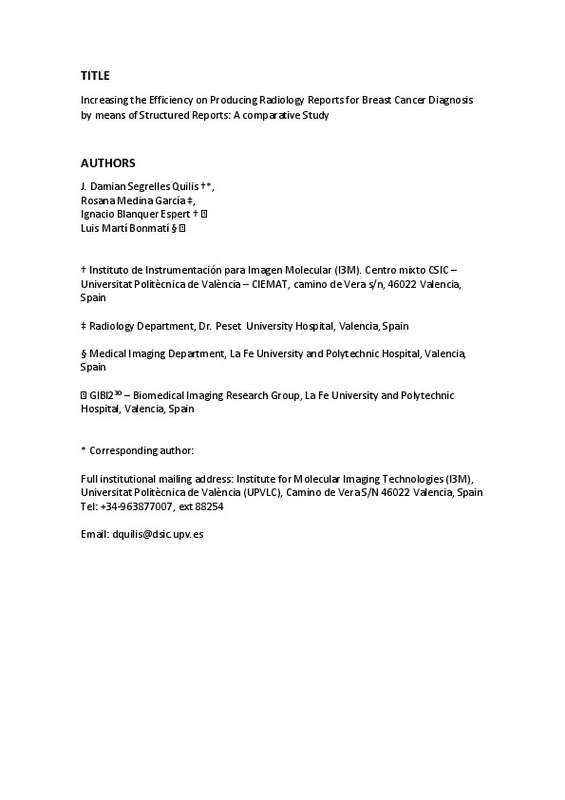JavaScript is disabled for your browser. Some features of this site may not work without it.
Buscar en RiuNet
Listar
Mi cuenta
Estadísticas
Ayuda RiuNet
Admin. UPV
Increasing the Efficiency on Producing Radiology Reports for Breast Cancer Diagnosis by Means of Structured Reports
Mostrar el registro sencillo del ítem
Ficheros en el ítem
| dc.contributor.author | Segrelles Quilis, José Damián
|
es_ES |
| dc.contributor.author | Medina, Rosana
|
es_ES |
| dc.contributor.author | Blanquer Espert, Ignacio
|
es_ES |
| dc.contributor.author | Marti Bonmati, Luis
|
es_ES |
| dc.date.accessioned | 2017-04-27T11:37:08Z | |
| dc.date.available | 2017-04-27T11:37:08Z | |
| dc.date.issued | 2017-02-21 | |
| dc.identifier.issn | 0026-1270 | |
| dc.identifier.uri | http://hdl.handle.net/10251/80123 | |
| dc.description.abstract | Background: Radiology reports are commonly written on free-text using voice recognition devices. Structured reports (SR) have a high potential but they are usually considered more difficult to fill-in so their adoption in clinical practice leads to a lower efficiency. However, some studies have demonstrated that in some cases, producing SRs may require shorter time than plain-text ones. This work focuses on the definition and demonstration of a methodology to evaluate the productivity of software tools for producing radiology reports. A set of SRs for breast cancer diagnosis based on BI-RADS have been developed using this method. An analysis of their efficiency with respect to free-text reports has been performed. Material and Methods: The methodology proposed compares the Elapsed Time (ET) on a set of radiological reports. Free-text reports are produced with the speech recognition devices used in the clinical practice. Structured reports are generated using a web application generated with TRENCADIS framework. A team of six radiologists with three different levels of experience in the breast cancer diagnosis was recruited. These radiologists performed the evaluation, each one introducing 50 reports for mammography, 50 for ultrasound scan and 50 for MRI using both approaches. Also, the Relative Efficiency (REF) was computed for each report, dividing the ET of both methods. We applied the T-Student (T-S) test to compare the ETs and the ANOVA test to compare the REFs. Both tests were computed using the SPSS software. Results: The study produced three DICOM-SR templates for Breast Cancer Diagnosis on mammography, ultrasound and MRI, using RADLEX terms based on BIRADs 5th edition. The T-S test on radiologists with high or intermediate profile, showed that the difference between the ET was only statistically significant for mammography and ultrasound. The ANOVA test performed grouping the REF by modalities, indicated that there were no significant differences between mammograms and ultrasound scans, but both have significant statistical differences with MRI. The ANOVA test of the REF for each modality, indicated that there were only significant differences in Mammography (ANOVA p = 0.024) and Ultrasound (ANOVA p = 0.008). The ANOVA test for each radiologist profile, indicated that there were significant differences on the high profile (ANOVA p = 0.028) and medium (ANOVA p = 0.045). Conclusions: In this work, we have defined and demonstrated a methodology to evaluate the productivity of software tools for producing radiology reports in Breast Cancer. We have evaluated that adopting Structured Reporting in mammography and ultrasound studies in breast cancer diagnosis improves the performance in producing reports. | es_ES |
| dc.description.sponsorship | INDIGO - DataCloud receives funding from the European Union's Horizon 2020 research and innovation programme under grant agreement RIA 653549. | en_EN |
| dc.language | Inglés | es_ES |
| dc.publisher | Schattauer | es_ES |
| dc.relation.ispartof | Methods of Information in Medicine | es_ES |
| dc.rights | Reserva de todos los derechos | es_ES |
| dc.subject | DICOM-SR | es_ES |
| dc.subject | Structured reporting | es_ES |
| dc.subject | Breast cancer | es_ES |
| dc.subject | BI-RADS | es_ES |
| dc.subject.classification | CIENCIAS DE LA COMPUTACION E INTELIGENCIA ARTIFICIAL | es_ES |
| dc.subject.classification | LENGUAJES Y SISTEMAS INFORMATICOS | es_ES |
| dc.title | Increasing the Efficiency on Producing Radiology Reports for Breast Cancer Diagnosis by Means of Structured Reports | es_ES |
| dc.type | Artículo | es_ES |
| dc.identifier.doi | 10.3414/ME16-01-0091 | |
| dc.relation.projectID | info:eu-repo/grantAgreement/EC/H2020/653549/EU/INtegrating Distributed data Infrastructures for Global ExplOitation/ | |
| dc.rights.accessRights | Abierto | es_ES |
| dc.contributor.affiliation | Universitat Politècnica de València. Escola Tècnica Superior d'Enginyeria Informàtica | es_ES |
| dc.contributor.affiliation | Universitat Politècnica de València. Escuela Técnica Superior de Ingeniería del Diseño - Escola Tècnica Superior d'Enginyeria del Disseny | es_ES |
| dc.description.bibliographicCitation | Segrelles Quilis, JD.; Medina, R.; Blanquer Espert, I.; Marti Bonmati, L. (2017). Increasing the Efficiency on Producing Radiology Reports for Breast Cancer Diagnosis by Means of Structured Reports. Methods of Information in Medicine. 56:1-13. https://doi.org/10.3414/ME16-01-0091 | es_ES |
| dc.description.accrualMethod | S | es_ES |
| dc.relation.publisherversion | https://doi.org/10.3414/ME16-01-0091 | es_ES |
| dc.description.upvformatpinicio | 1 | es_ES |
| dc.description.upvformatpfin | 13 | es_ES |
| dc.type.version | info:eu-repo/semantics/publishedVersion | es_ES |
| dc.description.volume | 56 | es_ES |
| dc.relation.senia | 327899 | es_ES |
| dc.contributor.funder | European Commission |







![[Cerrado]](/themes/UPV/images/candado.png)

